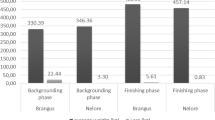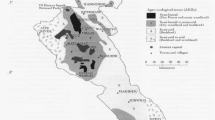Summary
Over 500 cattle of all age groups on 2 farms in Zimbabwe were immunised against theileriosis using the “infection and treatment” method and disease prevalence and their productivity assessed during a period of 18 months. The immunising stock,Theileria parva (Boleni) was isolated in Zimbabwe. None of the immunised cattle suffered from theileriosis upon natural exposure whereas 22 unimmunised cattle died of theileriosis and a further 48 required treatment for theileriosis.
In the first year, some immunised cattle were maintained with minimal threshold dipping (once or twice during the rainy season). During periods of very high tick challenge of 100 to 1,000Rhipicephalus appendiculatus per animal from January to March, a transient decrease in liveweight gain was observed particularly in cows. However, by the end of the period of observation, the weights had recovered so that intensively dipped and immunised and threshold or strategically dipped groups of cattle showed no significant differences. From the results it was estimated that each engorging femaleR. appendiculatus caused a temporary depression in weight gain of 8 grams. In young stock the weight loss was exacerbated by the presence of screw worm(Chrysomya bezziana) infestation.
It was then possible to define an economically attractive integrated tick and theileriosis control strategy based on these findings, whereby immunised cattle were dipped 6 times between mid-December and mid-March. In this regimen, no weight loss occurred and no cases of screw worm were observed.
For each of 3 herd sizes of 250, 500 and 1,000 cattle, comparisons were made of the costs of 4 different control options:
-
(i)
Intensive dipping (40 times/year)
-
(ii)
Intensive pour-on acaricide treatments (18 times/year)
-
(iii)
Theileria immunisation with strategic dipping (6 times/year)
-
(iv)
Theileria immunisation with pour-on treatment (4 times/year)
It is concluded from these studies that, on farms where theileriosis is a serious problem, immunisation coupled with a strategic dipping programme is economically very attractive. In the year in which immunisation is carried out, costs will be higher than for intensive dipping, but from the second year on, the costs are decreased to approximately 50% of those for intensive dipping.
Résumé
Dans 2 fermes du Zimbabwe, on a immunisé contre la theilériose plus de 500 têtes de bovins de tous âges par la méthode «infection et traitement»; la prevalence de la maladie et la productivité ont été suivis sur une période de 18 mois. La souche servant à la immunisation.Theileria parva (Boleni), a été isolée au Zimbabwe. Aucun des bovins immunisés n'a souffert de theilériose lors d'exposition naturelle, alors que parmi les non vaccinés 22 sont morts et 48 ont requis un traitement contre la theilériose.
Pendant la première année, une partie des bovins vaccinés n'a bénéficié de balnéation qu'à un seuil minimum (un à deux pendant la saison des pluies). Lors des périodes de très haute infestation ixodienne, 100 à 1000Rhipicephalus appendiculatus par animal de Janvier à Mars, on a observé une baisse transitoire de gain de poids journalier, en particulier chez les vaches. Toutefois, à la fin de la période d'observation, les poids étaient redevenus normaux si bien qu'il n'y avait plus de différence significative entre les groupes de bovins: balnéation intensive, immunisation et balnéation minimale ou stratégique. D'aprés les résultats, on a pu estimer que chaque femelle deR. appendiculatus engorgée provoquait une perte temporaire de 8 grammes en gain de poids. Chez les jeunes, la perte pondérale est augmentée par la présence de l'infestation par les larves deChrysomya bezziama.
Il a été possible d'élaborer une stratégie de contrôle attrayante et integrée contre les tiques et la theilériose en prenant en compte ces résultats: 6 balnéations entre mi-Décembre et mi-Mars pour les bovins immunisés. Dans ces conditions, aucune perte de poids ne se manifeste et on n'observe pas d'infestations parChrysomya bezziana.
On a calculé les coûts de chacune des 4 options de contrôle suivantes pour des troupeaux de 250, 500 et 1000 animaux:
-
i.
balnéation intensive (40 fois/an)
-
ii.
traitement acaricide intensif en pour-on (18 fois/an)
-
iii.
immunisation contre la theilériose et balnéation stratégique (6 fois/an)
-
iv.
immunisation contre la theilériose et traitement pour-on (4 fois/an)
De ces études, on conclut que dans les fermes où la theilériose est un sérieux probléme, l'immunisation associée à un programme de balnéation stratégique est économiquement attrayante. Dans l'année ou on pratique l'immunisation, les coûts seront supérieurs par rapport à la balnéation intensive mais, comparée à cette dernière, ils ne sont plus que de 50% à partir de la seconde année.
Resumen
Más de 500 cabezas de ganado vacuno de todas las edades fueron inmunizadas frente a la theileriosis utilizando et método de “infección y tratamiento” en dos granjas de Zimbabwe. Se estudió la prevalencia de la enfermedad y la productividad de los animales durante un período de 18 meses. La cepa utilizada para las inmunizaciones,Theileria parva (Boleni), fue aislada en Zimbabwe. Ninguno de los animales inmunizados sufrió theileriosis por exposición natural, mientras que 22 de los animales no tratados murieron de dicha enfermedad y otros 48 necesitaron tratamiento frente a ella.
Durante el primer año, algunos de los animales inmunizados recibieron un número mínimo de baños antigarrapatas (uno o dos baños durante la época de lluvias). Desde enero a marzo dichos animales sufrieron infestaciones severas—de 100 a 1000 garrapatas de la especieRhipicephalus appendiculatus por animal—y se observó una disminución transitoria en su crecimiento, particularmente en las vacas. Sin embargo, al final de dicho período los animales habían recuperado su peso y no se observó diferencia entre animales inmunizados que recibieron un número mínimo de baños y aquellos que recibieron un tratamiento intensivo de bańos. A partir de los resultados se estimó que cada garrapata hembra de la especieR. appendiculatus causó una disminución transitoria en el crecimiento de unos 8 gramos. En ganado jóven, la pérdida de peso fue mayor a consecuencia de la infestación por gusanos tornillo de la especieChrysomya bezziana.
De acurdo con estos resultados fue posible diseñar una estrategia de control frente a la theileriosis y a la infestación por garrapatas rentable económicamente. Dicha estrategia consistió en aplicar al ganado inmunizado 6 baños antigarrapatas desde mediados de diciembre hasta mediados de marzo. Los animales sometidos a este sistema de control no perdieron peso y no sufrieron infestaciones por gusanos tornillo.
Se compararon los costes de los cuatro métodos de control siguientes para rebaños de 250, 500 y 1000 animales:
-
(1)
tratamiento intensivo de baños (40 veces al ańo)
-
(2)
tratamiento intensivo con duchas acaricidas (18 veces al año)
-
(3)
inmunización frente a theileriosis con baños estratégicos (6 veces al año)
-
(4)
inmunización frente a theileriosis con duchas estratégicas (4 veces al año)
A partir de estos estudios se concluyó que, en aquellas granjas en las que la theileriosis es un problema serio, la inmunización junto a un programa de baños estratégicos es una opción muy atractiva desde el punto de vista económico. Si bien en el año en que se realizan las inmunizaciones el coste es superior al de un programa intensivo de baños, a partir del segundo año el coste se reduce a la mitad del de un programa intensivo de baños.
Similar content being viewed by others
References
Berkvens, D. L. (1991). Reassessment of tick control after immunization against East Coast fever in the Eastern Province of Zambia.Annales Societie Médecine Tropicale,71 (Suppl. 1), 87–94.
Burridge, M. J. &Kimber, C. D. (1972). The indirect fluorescent antibody test for experimental East Coast fever (Theileria parva infection of cattle). Evaluation of a cell culture schizont antigen.Research in Veterinary Science,13, 451–455.
Cook, A. J. C. (1991). Communal farmers and tick control—A field study in Zimbabwe.Tropical Animal Health and Production,23, 161–166.
Cranefield, P. F. (1991).Science and the Empire: East Coast fever in Rhodesia and the Transvaal. Cambridge University Press.
Dolan, T. T. (1993).Ticks and Tick-borne Disease Control. Proceedings of a Joint OAU, FAO, and ILRAD Workshop; ILRAD, Nairobi.
Fao (1993a) Studies on Theileriosis and Economics of Tick Control. II. Economics of Integrated Tick and Tick-borne Disease Control. Field Document no 2; FAO, Rome.
Fao (1993b). Studies on Theileriosis and Economics of Tick Control. IV. Procedure for the Production and Testing ofTheileria parva Stabilate for Use in Field Immunization. Field Document no 4; FAO, Rome.
Hove, T., Musisi, F. L., Kanhai, G. K., Latif, A., Masaka, S., Munatswa, F. C., Pegram, R. G., Kamwendo, S. P., Quiroga, J. C., Mwangondwe, R. &Dolan, T. T. (1995). Challenge ofT. parva (Boleni)-immunised cattle with selected East AfricanTheileria stocks.Tropical Animal Health and Production 27, 202–211.
Irvin, A. D., Morzaria, S. P., Munatswa, F. C. &Norval, R. A. I. (1989). Immunization of cattle with aTheileria parva bovis stock from Zimbabwe protects against challenge with virulentT.p. parva andT.p. lawrencei stocks from Kenya.Veterinary Parasitology,32, 271–278.
Koch, H. T., Norval, R. A. I., Ocama, J. G. R. &Munatswa, F. C. (1992). A study on theTheileria parva bovis carrier state.Preventative Veterinary Medicine,12, 197–203.
Lawrence, J. A. (1991a). Retrospective observations on the geographical relationship betweenRhipicephalus appendiculatus and East Coast fever in Southern Africa.The Veterinary Record,128, 180–183.
Lawrence, J. A. (1991b). Retrospective observations on the transmission of East Coast fever in Zimbabwe.Tropical Animal Health and Production,23, 69–74.
Lawrence, J. A. (1992). In:The Epidemiology of Theileriosis in Africa: (R. A. I. Norval, B. D. Perry, A. S. Young. Academic Press, London, pp 2–39.
Lawrence, J. A. &Mackenzie, P. K. (1980). Isolation of a non-pathogenicTheileria of cattle transmitted byRhipicephalus appendiculatus.Zimbabwe Veterinary Journal,11, 27–35.
Lawrence, J. A., Foggin, C. M. &Norval, R. A. I. (1980). The effects of war on the control of diseases of livestock in Rhodesia (Zimbabwe).The Veterinary Record,107, 82–85.
Lynen, G. M., Makala, L. H. C. &Pas, W. M. (1993) In:Ticks and Tick-borne Disease Control. Ed T. T. Dolan. Proceedings of a Joint OAU, FAO, and ILRA Workshop; ILRAD, Nairobi, pp, 16–21.
Morris, R. S. (1988). The effects of disease on productivity and profitability of livestock: How should it be assessed?Proceedings of the New Zealand Society of Animal Production,48, 117–125.
Mukhebi, A. W., Morzaria, S. P., Perry, B. D., Dolan, T. T. &Norval, R. A. I. (1990). Cost analysis of immunization for East Coast fever by the infection and treatment method.Preventative Veterinary Medicine,9, 207–219.
Mukhebi, A. W., Perry, B. D. &Kruska, R. (1991). Estimated economics of theileriosis control in Africa.Preventative Veterinary Medicine,12, 73–85.
Norval, R. A. I. (1990). The impact of pure infestations ofRhipicephalus appendiculatus andAmblyomma hebraeum on the productivity of cattle and implications for tick control strategies in Africa.Parassitologia,32, 155–164.
Pegram, R. G. &Chizyuka, H. G. B. (1990). The impact of natural infestations of ticks in Zambia on the productivity of cattle and implications for tick control strategies in Central Africa.Parassitologia,32, 165–175.
Perry, B. D. &Young, A. S. (1993). The naming game: the changing fortunes of East Coast fever andTheileria parva.The Veterinary Record,133, 613–616.
Perry, B. D., Mukhebi, A. W., Norval, R. A. I. &Barrett, J. C. (1990).A preliminary assessment of current and alternative tick and tick-borne disease control strategies in Zimbabwe. ILRAD, Nairobi. pp 41.
Radley, D. E. (1978). In:Tick-borne Diseases and their Vectors. Ed. J. K. H. Wilde. Proceedings of an International Conference; University of Edinburgh. pp 686–691.
Rapport, D. J. (1991). Myths in the foundations of economics and ecology.Biological Journal of the Linnaean Society,44, 185–202.
Uilenberg, G., Perie, N. M., Lawrence, J. A., De Vos, A. J., Paling, R. W. &Sponjer, A. A. M. (1982). Causal agents of bovine theileriosis in South Africa.Tropical Animal Health and Production,14, 127–140.
Author information
Authors and Affiliations
Rights and permissions
About this article
Cite this article
Pegram, R.G., James, A.D., Bamhare, C. et al. Effects of immunisation againstTheileria parva on beef cattle productivity and economics of control options. Trop Anim Health Prod 28, 99–111 (1996). https://doi.org/10.1007/BF02250733
Accepted:
Issue Date:
DOI: https://doi.org/10.1007/BF02250733




